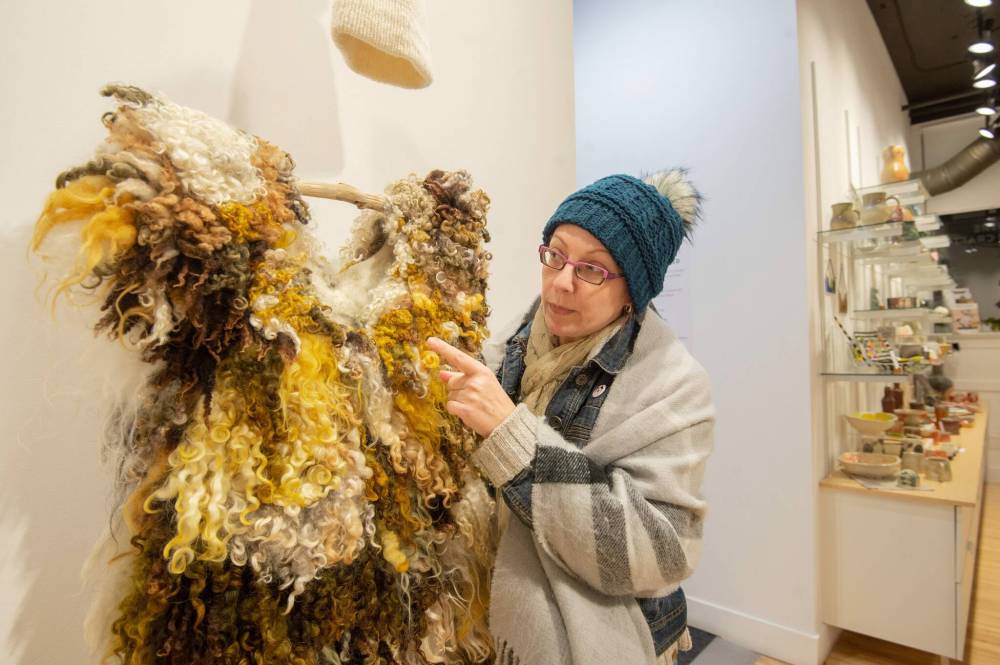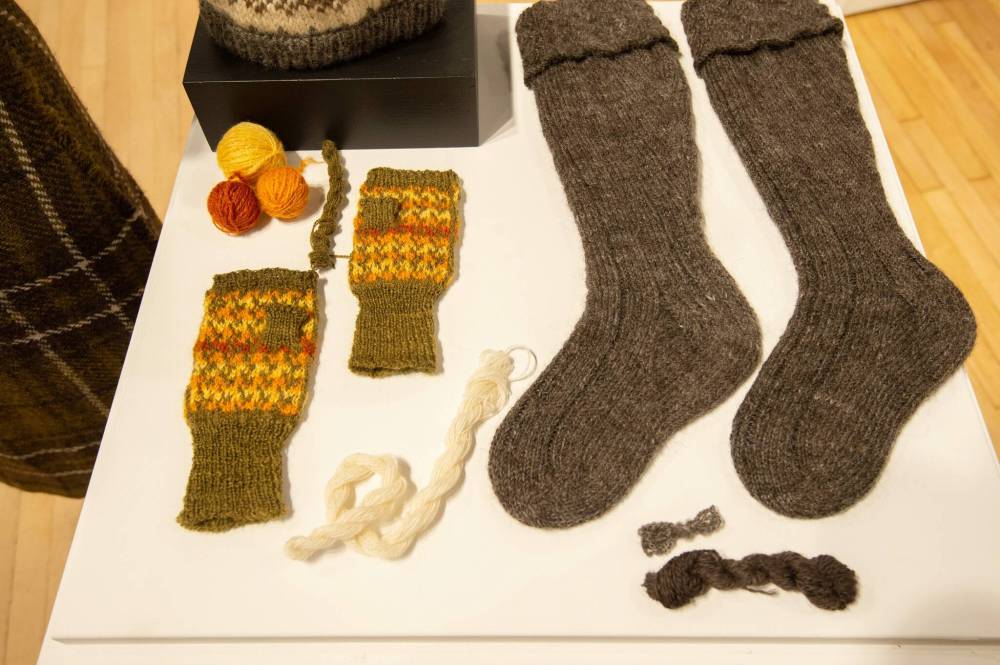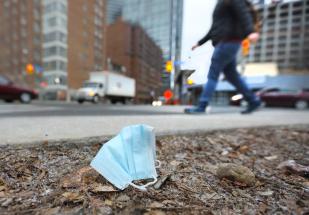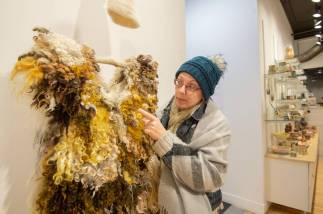Fibre optics Exhibition asks viewers to take a closer look at locally made textiles
Read this article for free:
or
Already have an account? Log in here »
To continue reading, please subscribe:
Monthly Digital Subscription
$0 for the first 4 weeks*
- Enjoy unlimited reading on winnipegfreepress.com
- Read the E-Edition, our digital replica newspaper
- Access News Break, our award-winning app
- Play interactive puzzles
*No charge for 4 weeks then price increases to the regular rate of $19.00 plus GST every four weeks. Offer available to new and qualified returning subscribers only. Cancel any time.
Monthly Digital Subscription
$4.75/week*
- Enjoy unlimited reading on winnipegfreepress.com
- Read the E-Edition, our digital replica newspaper
- Access News Break, our award-winning app
- Play interactive puzzles
*Billed as $19 plus GST every four weeks. Cancel any time.
To continue reading, please subscribe:
Add Free Press access to your Brandon Sun subscription for only an additional
$1 for the first 4 weeks*
*Your next subscription payment will increase by $1.00 and you will be charged $16.99 plus GST for four weeks. After four weeks, your payment will increase to $23.99 plus GST every four weeks.
Read unlimited articles for free today:
or
Already have an account? Log in here »
Hey there, time traveller!
This article was published 23/02/2022 (1387 days ago), so information in it may no longer be current.
February in Manitoba is a time for wool socks and sweaters.
What with the seemingly endless Environment Canada weather statements and alerts about blizzards and frigid temperatures, warm woollen outerwear has become almost as prevalent as face masks.
Art preview
The One Year, One Outfit Challenge
By the Pembina Fibreshed
● C2 Centre for Craft, 1-329 Cumberland Ave.
To Saturday
While woollens will likely be sported by those who visit the C2 Centre for Craft this week, it’s the ones on display on pedestals and tables that deliver the warm fuzzies to those who enjoy locally made products and celebrate the people who make them.
The One Year, One Outfit Challenge, presented by the Pembina Fibreshed, includes textiles made since Jan. 31, 2021, within a 200-mile radius of the Pembina Valley.
“The purpose was to take a year and really dig into what it takes to make our clothing,” says Anna Hunter, a co-director of the Pembina Fibreshed, an advocacy group for Manitoba fibre producers, manufacturers and dyers. “It really gave us an opportunity to connect and to bring farmers and artists and users together.”
That means every strand of wool that is on display until Saturday has been shorn from a Manitoba sheep, milled and spun in the province and dyed with products created from plants grown here.
The perfectly timed pop-up show, which opened on the eve of yet another blizzard on Feb. 18, is about more than displaying the skills of Manitoba crafters.

”Most of us have a small connection to the local food movement. Either we’ve been to a farmers market or maybe we know a farmer or we know when or where we can access local food,” Hunter says.
“Most people don’t even consider the fact that textile agriculture even exists, that the clothing we wear at one point probably started from the ground.”
Warmth in Winnipeg
Cold and snowy winters are a fact of life in Winnipeg, and this winter has proven to be colder and snowier than most.
Amid blizzards, extreme temperature warnings and icy breezes that can freeze skin in only a minute, there’s always something warm that can make these chilly months bearable.
Whether it’s to fight off winter’s chill or to create recreational activities, Winnipeg needs warmth to make it happen. Sometimes it is even the warmth in someone’s heart.
So maybe throw another log on the fire, or inch that blanket up a little further and join the Free Press on our investigation of this elusive, yet essential item of a Winnipeg winter.
Warmth.
The Pembina Fibreshed challenged its members to create one garment and two accessories from scratch for the show.
Hunter and her husband Luke raise sheep and operate Manitoba’s only wool-processing mill at Long Way Homestead near Ste-Geneviève, about 50 kilometres east of Winnipeg.
The homestead’s mill cleaned, spun and dyed most of the woollen textiles in the exhibition, and the Hunters sell skeins of yarn from their sheep, which are shorn by hand every spring.
‘We use nothing but hot water and a small amount of biodegradable citrus soap to clean all our fibre, and that grey water goes right back into our system,” Hunter says. “Washing wool means you’re taking dirt and lanolin and manure out of it and that goes right back into our pasture systems.”
She says about 90 per cent of Canada’s raw textiles, such as wool and linen, which is made from flaxseed, are exported, with Canada importing the finished products, whether they are wool sweaters or tuques, or linen garments.
“The textile agriculture and the textile-manufacturing industry is almost non-existent and that was the impetus for this project,” Hunter says. “Let’s talk about what it takes to source and make our clothing locally and some of the challenges within that, but also see the opportunity for how we can grow that industry and how we can build a resilient fibre economy.”

The exhibition also includes leather-based goods, such as vests, moccasins and wallets from elk that were hunted in the province, their hides tanned and tailored by Manitobans.
It has led to lovely knitted garments but also an appreciation for Manitoba’s ancestors, whether they were settlers who made all their own clothes or Indigenous people who found a use for almost every part of a wild animal they hunted successfully.
Among the pieces on display at the C2 Centre is a colourful wool tunic by Winnipeg craftswoman Maureen Winnicki Lyons. She used wool from more than 20 different breeds of sheep, as well as Angora goats and a host of dyes created by Manitoba flowers.
Unlike many knitted pieces in the exhibition, a felting process was used to create the woolly vest.

“I have a strange fascination with different breeds of wool,” Winnicki Lyons says during the exhibition’s debut. “I wanted to incorporate all the different wool that we have available in the province, because every breed of sheep has its own wool and all wool is useful for something.”
Hunter and other crafters make their own dyes from flowers they grow, such as Japanese indigo, tansy, goldenrod and even onion skin, which Hunter says make a golden colour.
To get different hues in their yarn, Winnicki Lyons and Hunter even add rusty nails recycled from old fence posts to the dyes.
While the exhibition’s theme and garments are eye-openers for visitors, Pembina Fibreshed’s crafters learned about the time-consuming process of making clothing the hard way.

Winnicki Lyons remembers the “laborious process” of fitting in more yarn in her tunic so there wouldn’t be gaps.
“We’ve travelled so far away from the source of our things in every way in life that this is just bringing it back home,” she says. “That’s something we need to, as a society, as a civilization, appreciate.”
alan.small@winnipegfreepress.com
Twitter: @AlanDSmall


Alan Small has been a journalist at the Free Press for more than 22 years in a variety of roles, the latest being a reporter in the Arts and Life section.
Our newsroom depends on a growing audience of readers to power our journalism. If you are not a paid reader, please consider becoming a subscriber.
Our newsroom depends on its audience of readers to power our journalism. Thank you for your support.







